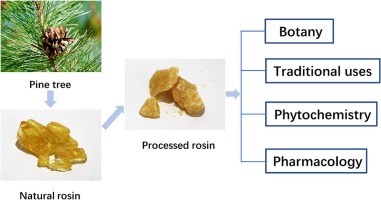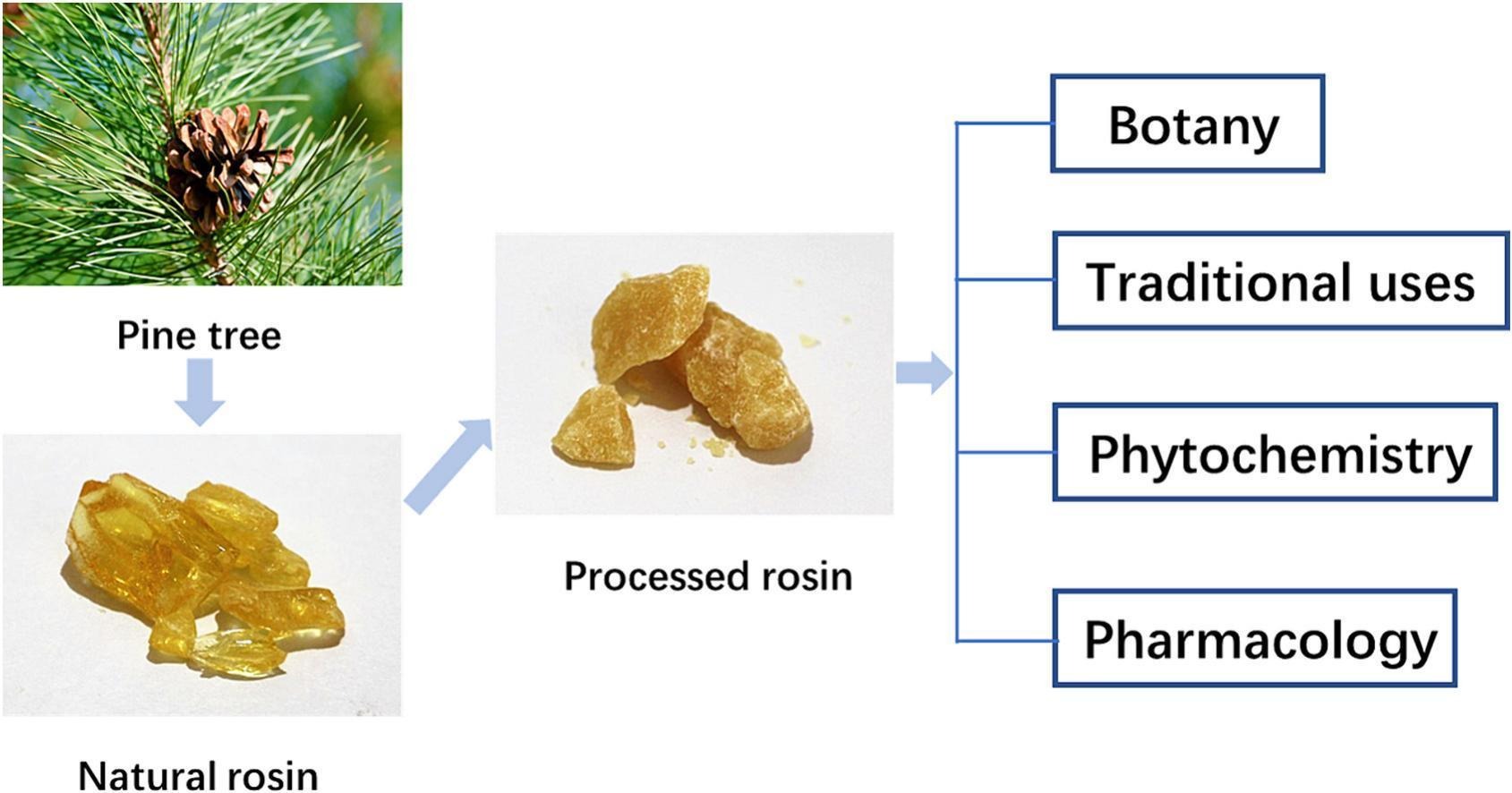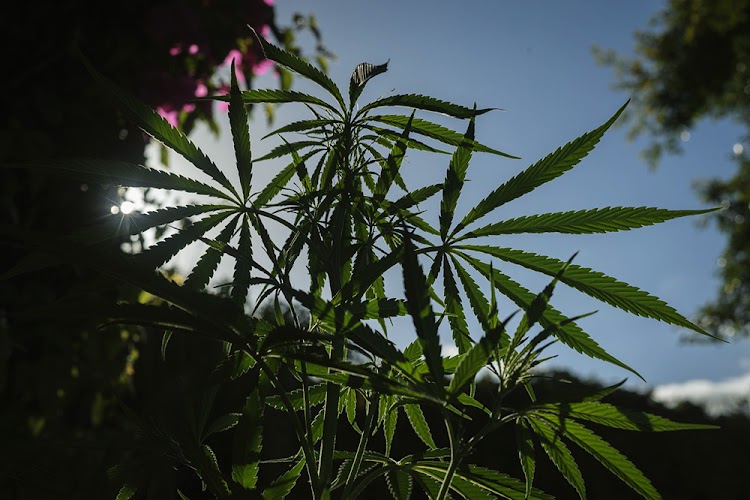Highlights
-
Rosin, a folk remedy, has long been used to treat inflammation skin diseases.
-
Rosin contains over 90% rosin acids (abietic- and pimaric-type rosin acids) and other diterpenoids.
-
Rosin acids have anti-microbial, anti-inflammation, anti-tumor, insecticidal activity, and others.
-
Abietic acid is a highly valuable potential lead compound due to its wide range of biological activities.
Abstract
Rosin, a natural resin obtained from conifer trees, has a long history of use in traditional folk medicine for treating abscesses, wounds, carbuncles, and burns, etc. It has been employed in ancient Egypt, China, Nordic countries, and Turkey as a therapeutic remedy. This comprehensive review examines the traditional uses, phytochemistry, and pharmacology of rosin, and it provides a critical update on current knowledge of rosin and identifies potential therapeutic opportunities. The chemical composition of rosin is known to vary depending on factors such as botanical sources, geographical locations, and processing methods. Rosin acids, which account for over 90% of its primary chemical constituents, have been identified as the predominant compounds in rosin. Researchers have isolated approximately 50 compounds from rosin, with terpenoid rosin acids being the most prevalent. Furthermore, the review highlights the potential pharmacological activities of rosin and its constituents. Crude extracts and isolated rosin acids have demonstrated promising properties, including antimicrobial, anti-inflammatory, anti-tumor, insecticidal, wound healing, and anti-obesity effects. However, the review emphasizes that further research is needed, as existing studies are predominantly preliminary. Many of the reported bioactivities require further verification, and the underlying mechanisms of action remain largely unexplored. In conclusion, rosin has been extensively used in traditional medicine across different cultures, and its chemical composition has been confirmed to a significant extent. The pharmacological activities observed in crude extracts and isolated rosin acids support its traditional uses. Nevertheless, additional research is necessary to deepen our understanding of the pharmacological mechanisms underlying its effects.
Graphical abstract

Introduction
Rosin is an amber-colored, transparent, glass-shaped natural biodegradable polymer that is extremely abundant in nature. It is the remaining solid resin after removing volatile components from the oleoresin exuded by various pine species [1].
Approximately 20 pine species are used commercially to produce rosin in many developing countries [2]. The major sources of rosin are P. massoniana Lamb., P. tabuliformis Carrière, P. palustris Mill., P. pinaster Aiton, P. sylvestris L., P. roxburghui Sarg., P. toeda L., and so on [1,3,4]. In China, P. massoniana Lamb., P. tabuliformis Carrière, I., P. yunnanensis Franch., P. densiflora Siebold & Zucc., and P. taiwanensis Hayata are often used as the main source of traditional Chinese medicine rosin, which is distillation residue of natural rosin after removing volatile components [4]. In the Nordic countries, especially in Finnish Lapland, the rosin used to treat acute and chronic infected wounds is from the Norway spruce [5]. In traditional Turkish folk medicine, the major sources of medicinal rosin are Pinus nigra subsp. pallasiana (Lamb.) Holmboe and P. sylvestris L. [6].
Rosin offers abundant raw materials, low cost, and versatile industrial applications. It is widely used in soap, paper, printing ink, paint, rubber, plastic, medicine, pesticide, and dyeing industry [7]. The most important uses are in paper-making chemicals, paints, and adhesives [3]. Furthermore, it has a variety of biological activities such as anti-inflammatory, ulcer treatment and drug additives. Therefore, rosin holds significant economic value and promising prospects for further research and development.
As an empirical folk remedy, rosin has long been used to treat inflammation skin diseases such as ulcer, punctured abscesses, and burns in ancient Egypt, Nordic countries, and Turkey [5,6]. In China, the medicinal use of rosin can be traced back to Divine Farmer’s Classic of Materia Medica (circa 25–220 CE) written more than two thousand years ago in Han dynasty. The book records that rosin can relieve various inflammation skin disorders. Zhonghua Bencao: Materia Medica of China (2005) records that rosin can be used to treat skin disorders including skin ulcer, wound, carbuncle; scrofula, fistula, psoriasis, scabies, tinea capitis, arthralgia, trauma, sprain, abnormal leukorrhea and thromboangiitis obliterans. As previously discussed, rosin demonstrates a wide range of potential biomedical applications. However, it is important to note that improper use of rosin can lead to side effects, such as gastrointestinal obstruction, which has garnered considerable attention [4,8].
It is described that improper use of rosin can lead to death from intestinal obstruction in Compilation of Materia Medica published in 1833. In China, almost all physicians attached great importance to the method of processing rosin in order to improve efficacy and reduce toxicity. Si-Miao Sun (581–682 CE), a renowned physician in the Tang Dynasty, provided a variety of rosin processing methods in his monograph Qianjin Yi Fang (A Supplement to Recipes Worth A Thousand Gold) [4]. Ancient medical scientists recognized that processing rosin can effectively reduce its toxicity and side effects, but determining their specific material basis for these side effects was challenging due to technological limitations. Historical records indicate that rosin can be derived from various plant sources, resulting in different compositions of rosin based on the plant origin and the specific processing methods employed [9]. The lack of standardized processing methods for rosin leads to inconsistent quality, hindering pharmaceutical market demands. Therefore, it is crucial to determine the chemical constituents and biological activities of rosin to establish quality standards, standardize processing methods, and expand its clinical applications. This review provides an overview of rosin’s components and biomedical activities, laying a foundation for future research.
Section snippets
Methodology of research
The available information of rosin (1948–2024) was collected from comprehensive scientific literature databases, including PubMed, Web of Science, Science Direct, CNKI, Google Scholar, Baidu Scholar, as well as various other sources such as books, dissertations. The keywords used in this review were rosin, resin, traditional uses, phytochemistry, and pharmacology. Scientific name and synonyms were checked with “World Flora Online” (www.worldfloraonline.org) or MPNS (http://mpns.kew.org).
Traditional uses
The therapeutic properties of rosin have been documented since ancient Egypt, where resin salves were employed for treating burns [5].
In China, the medicinal application of rosin can be traced back to the Divine Farmer’s Classic of Materia Medica, a renowned text written during the Han dynasty (around 25–220 CE) over two millennia ago. This ancient book documents rosin’s efficacy in alleviating diverse skin inflammations including carbuncle, refractory skin ulcer, scalp folliculitis, scabies,
Phytochemistry
The investigation into the chemical composition of rosin can be traced back to the early 19th century. In 1826, Baupe made the initial discovery that rosin contained crystallizable acids [3,10]. While the chemical composition of rosin may vary depending on botanical sources, geographical locations, and processing methods, rosin acids typically constitute >90% of its primary chemical constituents, accompanied by a minor proportion of non-acidic substances [3]. Rosin acids are an unstable
Anti-microbial activity
Rosin plays a crucial role in plants-defense, and AA is recognized as one of the key compounds that pine trees synthesize to protect against microorganisms. Consequently, the antibacterial activity of various chemical components present in rosin has garnered significant attention. Numerous studies have demonstrated the antibacterial properties of several rosin components, including AA and isopimaric acid [21,22].
Numerous in vitro experiments have consistently demonstrated the significant
Conclusion
Thousands of years ago, rosin was used as a folkloristic remedy for wound healing and dermatological diseases. In China, rosin has been widely utilized in the treatment of diverse conditions and remains a significant clinical drug to this day. Nevertheless, improper processing of rosin can lead to gastrointestinal side effects. Ancient Chinese medical scholars dedicated considerable efforts to studying rosin processing techniques, leading to significant enhancements in its clinical safety.
Authors’ contributions
X. Q. Li collected the information and drafted the manuscript; Y. Chen analyzed and edited the manuscript. All authors approved the final submitted version of the manuscript.
CRediT authorship contribution statement
Xiao Qiang Li: Writing – original draft, Investigation. Yong Chen: Writing – review & editing, Conceptualization.
Declaration of competing interest
The authors declare that they have no known competing financial interests or personal relationships that could have appeared to influence the work reported in this paper.
Acknowledgements
This work was financially supported by Key Research and Development Program of Shaanxi Province (2021SF-279), Xi’an Program of Science and Technology (21YXYJ0101) and Qing Lan Project of Jiangsu Province.
Courtesy Pubmed.com


